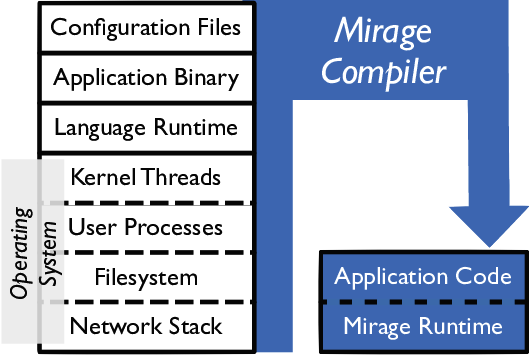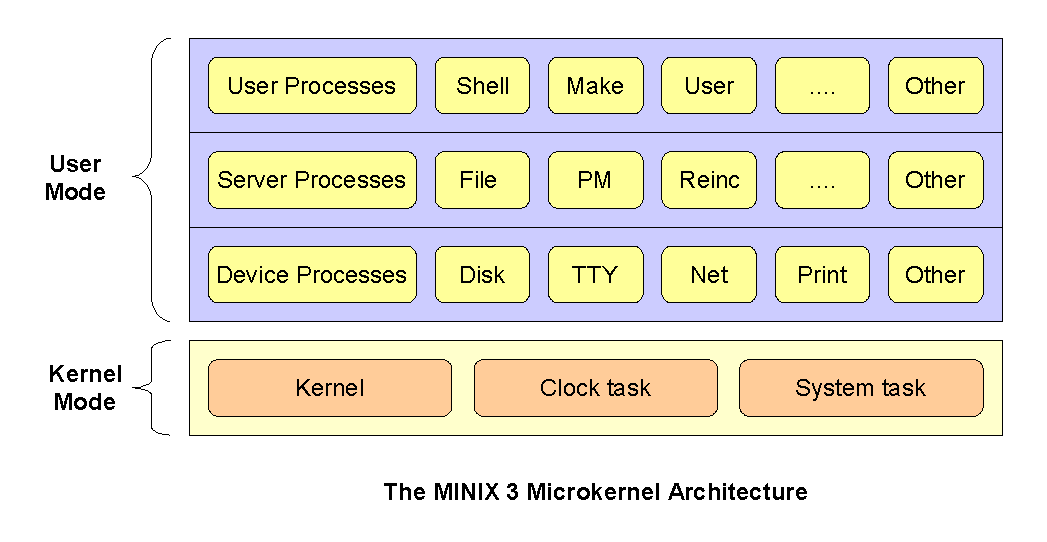|
Single Address Space Operating System
In computer science, a single address space operating system (or SASOS) is an operating system that provides only one globally shared address space for all processes. In a single address space operating system, numerically identical (virtual memory) logical addresses in different processes all refer to exactly the same byte of data. In a traditional OS with private per-process address space, memory protection is based on address space boundaries ("address space isolation"). Single address-space operating systems make translation and protection orthogonal, which in no way weakens protection. The core advantage is that pointers (i.e. memory references) have global validity, meaning their meaning is independent of the process using it. This allows sharing pointer-connected data structures across processes, and making them persistent, i.e. storing them on backup store. Some processor architectures have direct support for protection independent of translation. On such architectures, ... [...More Info...] [...Related Items...] OR: [Wikipedia] [Google] [Baidu] |
Computer Science
Computer science is the study of computation, information, and automation. Computer science spans Theoretical computer science, theoretical disciplines (such as algorithms, theory of computation, and information theory) to Applied science, applied disciplines (including the design and implementation of Computer architecture, hardware and Software engineering, software). Algorithms and data structures are central to computer science. The theory of computation concerns abstract models of computation and general classes of computational problem, problems that can be solved using them. The fields of cryptography and computer security involve studying the means for secure communication and preventing security vulnerabilities. Computer graphics (computer science), Computer graphics and computational geometry address the generation of images. Programming language theory considers different ways to describe computational processes, and database theory concerns the management of re ... [...More Info...] [...Related Items...] OR: [Wikipedia] [Google] [Baidu] |
NICTA
NICTA (formerly named National ICT Australia Ltd) was Australia's Information and Communications Technology (ICT) Research Centre of Excellence and is now known as CSIRO's Data61. The term "Centre of Excellence" is common marketing terminology used by some Australian government organisations for titles of science research groups. NICTA's role was to pursue potentially economically significant ICT related research for the Australian economy. NICTA was structured around groups focused primarily on pure research and implementing those ideas within business teams. When its funding ceased, NICTA merged with ''Commonwealth Scientific and Industrial Research Organisation'' (CSIRO) to form a new entity named CSIRO's Data61 on 28 August 2015. History In 2002, NICTA won a competitive selection process to be established as Australia's national centre of excellence in information and communications technology (ICT) research, under an Australian Government policy initiative to promote sci ... [...More Info...] [...Related Items...] OR: [Wikipedia] [Google] [Baidu] |
Flat Memory Model
Flat memory model or linear memory model refers to a memory addressing paradigm in which "memory appears to the program as a single contiguous address space." The CPU can directly (and linearly) address all of the available memory locations without having to resort to any sort of bank switching, memory segmentation or paging schemes. Memory management and address translation can still be implemented ''on top of'' a flat memory model in order to facilitate the operating system's functionality, resource protection, multitasking or to increase the memory capacity beyond the limits imposed by the processor's physical address space, but the key feature of a flat memory model is that the entire memory space is linear, sequential and contiguous. In a simple controller, or in a ''single tasking'' embedded application, where memory management is not needed nor desirable, the flat memory model is the most appropriate, because it provides the simplest interface from the programmer's poin ... [...More Info...] [...Related Items...] OR: [Wikipedia] [Google] [Baidu] |
Unikernel
A unikernel is a type of computer program that is static linking, statically linked with the operating system code on which it depends. Unikernels are built with a specialized compiler that identifies the operating system services that a program uses and links it with one or more Operating_system#Library, library operating systems that provide them. Such a program requires no separate operating system and can run instead as the guest of a hypervisor. The unikernel architecture builds on concepts developed by Exokernel and Nemesis (operating system), Nemesis in the late 1990s. Design In a library operating system, protection boundaries are pushed to the lowest hardware layers, resulting in: # a set of libraries that implement mechanisms such as those needed to drive hardware or talk network protocols; # a set of policies that enforce access control and isolation in the application layer. The library OS architecture has several advantages and disadvantages compared with convent ... [...More Info...] [...Related Items...] OR: [Wikipedia] [Google] [Baidu] |
Nanokernel
In computer science, a microkernel (often abbreviated as μ-kernel) is the near-minimum amount of software that can provide the mechanisms needed to implement an operating system (OS). These mechanisms include low-level address space management, thread management, and inter-process communication (IPC). If the hardware provides multiple rings or CPU modes, the microkernel may be the only software executing at the most privileged level, which is generally referred to as supervisor or kernel mode. Traditional operating system functions, such as device drivers, protocol stacks and file systems, are typically removed from the microkernel itself and are instead run in user space. In terms of the source code size, microkernels are often smaller than monolithic kernels. The MINIX 3 microkernel, for example, has only approximately 12,000 lines of code. History Microkernels trace their roots back to Danish computer pioneer Per Brinch Hansen and his tenure in Danish computer co ... [...More Info...] [...Related Items...] OR: [Wikipedia] [Google] [Baidu] |
Kernel (operating System)
A kernel is a computer program at the core of a computer's operating system that always has complete control over everything in the system. The kernel is also responsible for preventing and mitigating conflicts between different processes. It is the portion of the operating system code that is always resident in memory and facilitates interactions between hardware and software components. A full kernel controls all hardware resources (e.g. I/O, memory, cryptography) via device drivers, arbitrates conflicts between processes concerning such resources, and optimizes the use of common resources, such as CPU, cache, file systems, and network sockets. On most systems, the kernel is one of the first programs loaded on startup (after the bootloader). It handles the rest of startup as well as memory, peripherals, and input/output (I/O) requests from software, translating them into data-processing instructions for the central processing unit. The critical code of the kernel is usua ... [...More Info...] [...Related Items...] OR: [Wikipedia] [Google] [Baidu] |
Hybrid Kernel
A hybrid kernel is an operating system Kernel (operating system), kernel whose architecture attempts to combine aspects and benefits of microkernel and monolithic kernel architectures used in operating systems. Overview The traditional kernel categories are monolithic kernels and microkernels (with nanokernels and exokernels seen as more extreme versions of microkernels). The "hybrid" category is controversial, due to the similarity of hybrid kernels and ordinary monolithic kernels; the term has been dismissed by Linus Torvalds as simple marketing. The idea behind a hybrid kernel is to have a kernel structure similar to that of a microkernel, but to implement that structure in the manner of a monolithic kernel. In contrast to a microkernel, all (or nearly all) operating system services in a hybrid kernel are still in user space and kernel space, kernel space. There are none of the reliability benefits of having services in user space and kernel space, user space, as with a microke ... [...More Info...] [...Related Items...] OR: [Wikipedia] [Google] [Baidu] |
Exokernel
Exokernel is an operating system kernel developed by the MIT Parallel and Distributed Operating Systems group, and also a class of similar operating systems. Operating systems generally present hardware resources to applications through high-level abstractions such as (virtual) file systems. The idea behind exokernels is to force as few abstractions as possible on application developers, enabling them to make as many decisions as possible about hardware abstractions. Exokernels are tiny, since functionality is limited to ensuring protection and multiplexing In telecommunications and computer networking, multiplexing (sometimes contracted to muxing) is a method by which multiple analog or digital signals are combined into one signal over a shared medium. The aim is to share a scarce resource� ... of resources, which is considerably simpler than conventional microkernels' implementation of message passing and monolithic kernels' implementation of high-level abstractions. ... [...More Info...] [...Related Items...] OR: [Wikipedia] [Google] [Baidu] |
Singularity (operating System)
Singularity is an experimental operating system developed by Microsoft Research between July 9, 2003, and February 7, 2015. It was designed as a high dependability OS in which the kernel, device drivers, and application software were all written in managed code. Internal security uses type safety instead of hardware memory protection. Operation The lowest-level x86 interrupt dispatch code is written in assembly language and C. Once this code has done its job, it invokes the kernel, which runtime system and garbage collector are written in Sing# (an extended version of Spec#, itself an extension of C#) and runs in unprotected mode. The hardware abstraction layer is written in C++ and runs in protected mode. There is also some C code to handle debugging. The computer's basic input/output system (BIOS) is invoked during the 16-bit real mode bootstrap stage; once in 32-bit mode, Singularity never invokes the BIOS again, but invokes device drivers written in Sing#. Duri ... [...More Info...] [...Related Items...] OR: [Wikipedia] [Google] [Baidu] |
Phantom OS
Phantom OS is an Persistence_(computer_science)#Orthogonal_or_transparent_persistence, orthogonally persistent managed code general-purpose operating system. It is based on a concept of persistent virtual memory, and executes bytecode in a virtual machine. It is one of a few OSes not based on the classic concepts of Unix-like systems. Phantom is based on the principle that "Everything is an Object (computer science), object", in contrast to the Unix-like approach of "Everything is a file". Overview Phantom was founded by and is being developed mostly by Russian programmers. It is free and open-source software (FOSS) released under a GNU Lesser General Public License (LGPL). Basics Managed code – Memory protection on object level, rather than Process (computing), process level; absence of pointer arithmetic in managed code avoids many problems that exist and occur in unmanaged code. Global address space – Inexpensive inter-process communication (IPC). Single address space ... [...More Info...] [...Related Items...] OR: [Wikipedia] [Google] [Baidu] |
JX (operating System)
JX is a free, open source, microkernel operating system developed by the University of Erlangen with both the kernel and applications implemented using the Java programming language. Overview JX is implemented as an extended Java virtual machine (the ''JX Core''), adding support to the Java system for features such as protection domains and hardware access, along with several components written in Java that provide kernel facilities to applications running on the computer. Because Java is a type-safe language, JX can provide isolation between running applications without needing to use hardware memory protection. This technique, known as language-based protection means that system calls and inter-process communication In computer science, interprocess communication (IPC) is the sharing of data between running Process (computing), processes in a computer system. Mechanisms for IPC may be provided by an operating system. Applications which use IPC are often cat ... in JX ... [...More Info...] [...Related Items...] OR: [Wikipedia] [Google] [Baidu] |


